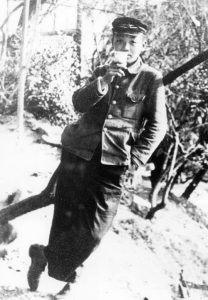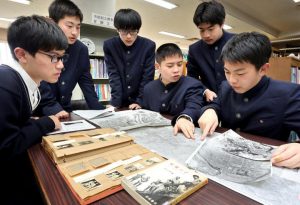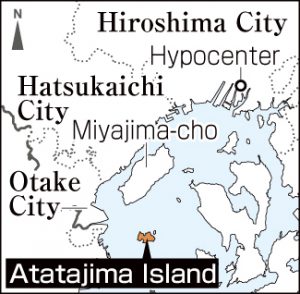Striving to fill voids in Hiroshima, evidence of victims remains—Deaths from leukemia, Part 1: Children of the A-bomb
Mar. 20, 2023
by Kyosuke Mizukawa, Senior Staff Writer
The atomic bombs dropped by the U.S. military on Hiroshima and Nagasaki 78 years ago led to an increase in radiation-induced leukemia after the war, with incidence of the disease peaking around 10 years after the bombings. Famously, Sadako Sasaki folded paper cranes in the hopes of recovering from the leukemia of which she died in 1955. With the summit meeting of the G7 (Group of Seven industrialized nations) set to take place in Hiroshima in two months, the Chugoku Shimbun will endeavor to trace the lives of A-bomb victims who died of leukemia through personal accounts and testimonies, focusing on the inhumane nature of nuclear weapons that continued to devastate peaceful life even in the post-war period.
The book Children of the A-bomb, a collection of accounts of children who experienced the atomic bombing, was published in October 1951, six years after the bombing, and continues to be read to this day. Of the 105 accounts included in the book, the story of Hisato Ito, who was 10 years old at the time of the bombing, is replete with his expectations for Hiroshima’s reconstruction. He wrote his personal account while a second-year student at Sanyo High School in Hiroshima City.
“Hiroshima will be reconstructed wonderfully by the citizens of Hiroshima, by the people of Japan and, more broadly, by people throughout the world.” Since that time, Hiroshima has become the vibrant city he had hoped for. However, he was struck by leukemia and lost his life at the young age of 17.
Rescued by mother after atomic bombing
Before the atomic bombing, Hisato lived on Atatajima Island (now part of Otake City) with his father, who was the manager of a local lighthouse, mother, and younger brother. On August 5, 1945, he was staying in Hiroshima with his mother, Noboru, then 38, and his eight-month-old brother, Masato, to meet up with his older brother, Izuo, then 14, who was staying at a boarding house in order to attend school in Hiroshima. The next morning, while Hisato was playing with a cat at the entrance of a local inn, he saw a flash of light.
That was about 800 meters from the hypocenter. He became trapped under the collapsed building, but his mother, removing burning logs and planks, helped him escape. “I will always remember how ecstatic I was at that moment,” he wrote in his personal account of that time. However, his younger brother did not survive, and his older brother, who had been mobilized to help in the work of demolishing buildings to create fire lanes for the war effort, was also killed.
To make matters worse, his mother fell ill after returning to the island and died on August 26. For his part, Hisato lost hair and felt lethargic. He tried moxibustion treatment, which he was told would alleviate his symptoms, and after some time regained his health.
After the war, his father remarried and began working at the 6th Regional Coast Guard Headquarters, located in Hiroshima, and Hisato lived with his father and new mother in a nearby official residence. In 1951, when he was a second-year student at Sanyo High School, his father got a new job and moved to Osaka. Because Hisato wanted to remain in Hiroshima, he commuted to school from a boarding house. In his personal account written in 1951 at the request of the late Arata Osada, a professor at Hiroshima University, he indicated that he was “living happily.”
Shortly after that, however, he fell ill and was admitted to a hospital in Hiroshima. When his parents rushed to the hospital to care for him, Hisato shed tears. He passed away in December 1951, two months after publication of Children of the A-bomb. “Please give me moxibustion treatment,” he pleaded in a feeble voice before passing away.
Younger students retrace Ito’s footsteps
The premature death of Hisato was touched on in Mr. Osada’s own memoir and in this newspaper’s 1995 series titled “Light in the Distance,” which told the story of the Ito family, with a focus on the lighthouse where his father had worked during the war. Not many related materials remain, however. Children of the A-Bomb did not provide the name of the writer’s school and, with that, Hisato is not a well-known figure even at Sanyo High School, his alma mater.
However, six students who belong to the school’s library club have been researching his short life since the beginning of this year. That effort got its start when Seigo Nishioka, 91, a resident of Hatsukaichi City, shared his experience of the atomic bombing during the students’ peace study class last year. He told them about Hisato, because Mr. Nishioka was a close friend of Hisato’s brother, Izuo.
“I never imagined there were students like Mr. Ito who were unable to return to school,” said Keiji Sasaki, a second-year student and a member of the library club. He began researching what health effects the bomb’s radiation had on A-bomb survivors’ health, including the documented increase in incidence of leukemia. He and other members of the club visited Atatajima Island and have been retracing the route Hisato took around the time of the atomic bombing.
The library club members are driven by the wishes that Mr. Ito spelled out in his personal account. “Please do not use atomic bombs in war,” he wrote. “Please make sure that peaceful smiles fill countries throughout the world.” The students plan to write up their findings and make a presentation at the school before this year’s anniversary of the atomic bombing.
(Originally published of March 20, 2023)
The atomic bombs dropped by the U.S. military on Hiroshima and Nagasaki 78 years ago led to an increase in radiation-induced leukemia after the war, with incidence of the disease peaking around 10 years after the bombings. Famously, Sadako Sasaki folded paper cranes in the hopes of recovering from the leukemia of which she died in 1955. With the summit meeting of the G7 (Group of Seven industrialized nations) set to take place in Hiroshima in two months, the Chugoku Shimbun will endeavor to trace the lives of A-bomb victims who died of leukemia through personal accounts and testimonies, focusing on the inhumane nature of nuclear weapons that continued to devastate peaceful life even in the post-war period.
17-year-old wishes for reconstruction, peace
The book Children of the A-bomb, a collection of accounts of children who experienced the atomic bombing, was published in October 1951, six years after the bombing, and continues to be read to this day. Of the 105 accounts included in the book, the story of Hisato Ito, who was 10 years old at the time of the bombing, is replete with his expectations for Hiroshima’s reconstruction. He wrote his personal account while a second-year student at Sanyo High School in Hiroshima City.
“Hiroshima will be reconstructed wonderfully by the citizens of Hiroshima, by the people of Japan and, more broadly, by people throughout the world.” Since that time, Hiroshima has become the vibrant city he had hoped for. However, he was struck by leukemia and lost his life at the young age of 17.
Rescued by mother after atomic bombing
Before the atomic bombing, Hisato lived on Atatajima Island (now part of Otake City) with his father, who was the manager of a local lighthouse, mother, and younger brother. On August 5, 1945, he was staying in Hiroshima with his mother, Noboru, then 38, and his eight-month-old brother, Masato, to meet up with his older brother, Izuo, then 14, who was staying at a boarding house in order to attend school in Hiroshima. The next morning, while Hisato was playing with a cat at the entrance of a local inn, he saw a flash of light.
That was about 800 meters from the hypocenter. He became trapped under the collapsed building, but his mother, removing burning logs and planks, helped him escape. “I will always remember how ecstatic I was at that moment,” he wrote in his personal account of that time. However, his younger brother did not survive, and his older brother, who had been mobilized to help in the work of demolishing buildings to create fire lanes for the war effort, was also killed.
To make matters worse, his mother fell ill after returning to the island and died on August 26. For his part, Hisato lost hair and felt lethargic. He tried moxibustion treatment, which he was told would alleviate his symptoms, and after some time regained his health.
After the war, his father remarried and began working at the 6th Regional Coast Guard Headquarters, located in Hiroshima, and Hisato lived with his father and new mother in a nearby official residence. In 1951, when he was a second-year student at Sanyo High School, his father got a new job and moved to Osaka. Because Hisato wanted to remain in Hiroshima, he commuted to school from a boarding house. In his personal account written in 1951 at the request of the late Arata Osada, a professor at Hiroshima University, he indicated that he was “living happily.”
Shortly after that, however, he fell ill and was admitted to a hospital in Hiroshima. When his parents rushed to the hospital to care for him, Hisato shed tears. He passed away in December 1951, two months after publication of Children of the A-bomb. “Please give me moxibustion treatment,” he pleaded in a feeble voice before passing away.
Younger students retrace Ito’s footsteps
The premature death of Hisato was touched on in Mr. Osada’s own memoir and in this newspaper’s 1995 series titled “Light in the Distance,” which told the story of the Ito family, with a focus on the lighthouse where his father had worked during the war. Not many related materials remain, however. Children of the A-Bomb did not provide the name of the writer’s school and, with that, Hisato is not a well-known figure even at Sanyo High School, his alma mater.
However, six students who belong to the school’s library club have been researching his short life since the beginning of this year. That effort got its start when Seigo Nishioka, 91, a resident of Hatsukaichi City, shared his experience of the atomic bombing during the students’ peace study class last year. He told them about Hisato, because Mr. Nishioka was a close friend of Hisato’s brother, Izuo.
“I never imagined there were students like Mr. Ito who were unable to return to school,” said Keiji Sasaki, a second-year student and a member of the library club. He began researching what health effects the bomb’s radiation had on A-bomb survivors’ health, including the documented increase in incidence of leukemia. He and other members of the club visited Atatajima Island and have been retracing the route Hisato took around the time of the atomic bombing.
The library club members are driven by the wishes that Mr. Ito spelled out in his personal account. “Please do not use atomic bombs in war,” he wrote. “Please make sure that peaceful smiles fill countries throughout the world.” The students plan to write up their findings and make a presentation at the school before this year’s anniversary of the atomic bombing.
(Originally published of March 20, 2023)










